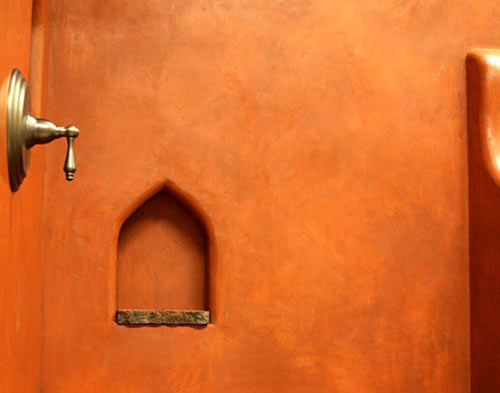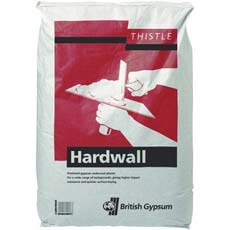Plaster is used the world over in order to cover the interior walls of a building in order to provide a flat, stable surface for, most commonly, paint or wallpaper.
As there are several different types of plaster it’s important to know which type should be used in which situation, so read on below to find out all you need to know about the types of plaster and their uses.
What are the Most Commonly Used Types of Plaster?
The 2 most common types of plaster used in the UK today tend to be modern gypsum-based plasters or more traditional lime plasters, each has its own specific use case. Gypsum plasters are generally the most popular and are the internal covering of choice for the majority of UK homes.
Lime-based plasters tend to be a little more specialist and are generally used on older properties due to the fact they’re breathable. This ensures that damp issues and condensation problems are avoided as the moisture that causes them isn’t trapped and can naturally evaporate.
Another great feature is that they are also much more flexible than gypsum plaster which again lends itself well to period properties that can often experience a lot of movement. As the plaster moves with the building it doesn’t crack or degrade.
Unfortunately, newer gypsum plaster is no where near as flexible or breathable as traditional lime plaster, however as modern homes don’t suffer anywhere near as much with damp, condensation and movement this generally isn’t an issue.
Lime and gypsum plasters are also made using different ingredients. Lime plaster is made using lime (obviously) but also cement, sand and water. Quite often to strengthen the mix up additional fibres will be mixed in such as horse hair and the similar.
Gypsum plaster on the other hand is made is several different ways depending on the type of plaster, but most involve using gypsum rock which is then ground down to a powder and then heated to remove some or all of the water content.

Room plastered using modern gypsum-based plaster
What are the Other Types of Plaster?
Aside from common gypsum and traditional lime plaster there are quite a few others and these include Venetian plaster, Tadelakt plaster, cement plaster and clay plaster.
Although they all achieve exactly the same thing, e.g. provide a decorative finished coating for an internal wall, they are all mixed and applied in very different ways.
Venetian Plaster
Venetian plaster, or polished plaster as it’s also known is many thousands of years old and one of the most traditional forms of plastering and was used extensively by the Romans and Greeks.
Venetian plaster is know by quite a few other names including Spatulato, Marmorino, Marble plaster, Italian plaster or Stucco Veneziano. Aside from its ancient usage, it fell out of favour until around the mid 1500’s when it was given a rebirth in Italy.
The traditional recipe for making polished plaster is to use naturally occurring pigments and dyes and also lime putty, however today other more modern ingredients can also be used and slight variations on mixes and application are used to produce slightly different finishes, hence the number of different names.
When applied correctly, Venetian or polished plaster can look absolutely stunning and provide a real feature. It can also be waxed over to provide a finish suitable for kitchens and bathrooms, however due to the processes involved in getting it on the wall it’s very expensive.
To find out more about Venetian plaster, see our project here.

Venetian polished plaster
Tadelakt Plaster
Tadelakt plaster, or traditional Moroccan plaster as it’s also known is another form of lime-based plaster that was developed in the Moroccan city of Marrakesh.
Not only does Tadelakt plaster provide a great finish for pretty much any room and style e.g. traditional or modern contemporary, one of it’s main benefits is that when applied correctly it will give a totally waterproof finish that is resistant to mould.
Due to this it is also a great substitute for tiles so can be used in bathrooms, shower rooms, wet rooms and kitchens.
Other great advantages are that it is also very hardwearing so is ideal for use in fairly high traffic areas and it can also be coloured during mixing so you don’t have to paint it afterwards.
Tadelakt plaster is applied in a similar way to other plasters in that it is spread on the wall in several coats, but the last coat is then polished smooth whilst also applying an olive oil soap that’s rubbed over the surface to close it and make it water tight.

Traditional tadelakt plaster finish – Image courtesy of stuccoitaliano.com
Cement Plaster
As you may guess from the name, unlike gypsum or lime plasters, cement plaster is made using cement mixed with sand and water as you would to mix a mortar, only it is then spread across a walls surface to provide a plaster-like finish.
As cement plaster tends to be a little stiffer than it’s lime and gypsum counterparts it can be a little trickier to spread and get totally flat and smooth , however one great advantage is that you generally only need to apply a single coat
Despite these few advantages, unlike lime and gypsum, cement plaster is neither breathable nor flexible so certai8nly shouldn’t be used on older period properties.

Cement plaster spread on to wall
Clay Plaster
Like Venetian and Tadelakt plaster, clay plaster is another traditional form of plastering that, over recent years, has enjoyed some what of a come back.
Unlike other more modern plasters, clay plaster is extremely environmentally friendly as, in it’s traditional form, only uses natural ingredients, clay being the main one but also sand and sometimes natural hair to increase strength.
To avoid using paint, it can also be coloured with natural dyes and pigments for a natural coloured finish.
The one big disadvantage that clay plaster has is that it doesn’t fair well around water and moisture so can’t really be used in kitchens and bathrooms, however is does breath very well, similar to lime-based plasters.

Traditional clay plaster finish – Image courtesy of forman-earthsandlimes.com
When Should you use Lime Plaster?
Traditional lime plaster has some very unique features in that it is very breathable and also very flexible. Both of these attributes are ideal for use with older period properties that quite often suffer from condensation, damp and movement.
If gypsum or another type of plaster was used then it is likely that a great deal of issues would occur in that moisture wouldn’t be able to escape and naturally evaporate and would then develope into damp and as the plaster wouldn’t move with the structure it would simply crack and fail.

Traditional lime plaster
When Should you use Gypsum-Based Plaster?
As gypsum plasters are fairly modern they tend to be used exclusively on modern properties and buildings. As they do not breath and flex any where near as well as traditional lime plaster, it’s generally not a good idea to use them on period properties as they can trap moisture, cause damp and crack easily.
As pretty much all modern properties are either painted or wallpapered internally, both of these finishes require a dead flat surface to look they’re absolute best and when applied correctly, this is exactly what a gypsum plaster will provide.

Freshly gypsum plastered walls and ceiling
What are the Main Types of Gypsum Plaster?
The plasters below are all Thistle plasters and made by British Gypsum, probably the biggest supplier in the UK. They are the plasters a plasterer will use and if it’s good enough for the pros, it’s good enough for the DIY enthusiast.
There is nothing particularly wrong with stores “own brand” plasters but Thistle plasters are no more expensive, and are generally regarded as the best.
Different Types of Gypsum Plaster
As gypsum plaster is the most commonly used type of plaster, here follows the different types you are likely to encounter.
Bonding Plaster
Bonding is an undercoat plaster. This means it is the first coat, or undercoat to be applied to a new (or to be patched) wall. When it is trowelled off, it is scratched with a nail to give a “key” for the top coat, or finish plaster to adhere to. Bonding plaster has incredible “stickabilty” and does not rely on an absorbent surface to bond to.
Bonding can be applied to really dense concrete blocks or engineering bricks and even concrete itself. These surfaces are where you would use bonding plaster as a scratch coat. Bonding does not need the wall underneath to be scratched or have a mechanical “key” and bonding agents, such as latex SBR adhesive are usually applied to the wall before the bonding plaster itself.

Bonding plaster
Browning Plaster
Browning plaster is also an undercoat plaster for use on more absorbent surfaces.
Browning plaster works much better on surfaces with a mechanical key and you will often see bricklayers “raking out” the joints of block and brick walls which are to have a Browning plaster covering.

Browning plaster
Hardwall Plaster
Hardwall is similar to Browning except that it offers a higher impact resistance and quicker drying surface. It is the most often used undercoat plaster these days, and can be applied to most masonry surfaces.

Hardwall plaster
Tough Coat Plaster
Even tougher than Hardwall as an undercoat plaster, and has a greater coverage based on the nominal depth of 11mm. Again, suitable for most masonry walls.

Tough Coat plaster
Dri-Coat Plaster
Dri-coat plaster is a cement-based plaster used when resurfacing a wall after installation of a new DPC.

Dri-Coat plaster
Multi-Finish Plaster
Thistle multifinish is a top coat plaster which is suitable for a great finish on all the other surfaces. Multifinish is ideal for (indeed, is manufactured for) using as a finishing plaster when there are a variety of backing surfaces to be covered.

Multi-Finish plaster
Board Finish
Board finish plaster is used on surfaces with low – medium suction. Plasterboard and Dry-Coat plaster will accept Board Finish well.

Board Finish plaster
One Coat Plaster
Sometimes called patching plaster, this plaster is a mix of something like binding plaster and multifinish. It is designed to fill patches in one go and can be “laid on” to far greater thicknesses than normal undercoat plasters. Anything up to 50mm some manufacturers claim.
We would not advocate laying on at any more than 25mm. Once on the wall this plaster can be trowelled up to a very smooth finish and no further application is required. No matter how hard we have tried over the years we cannot get as good a finish with One Coat as we can with two coat plaster work. But that’s our problem – You have a try!

Universal One Coat plaster
How is Gypsum Plaster Applied?
When plastering with a gypsum-based plaster, as most homes in the UK are, it is applied to the wall in 2 separate coats, the first coat being a base coat and the second coat being a finishing or skim coat.
The first base coat is mixed using bonding or browning plaster as it’s known and it is laid on to a bare brick or block wall at a thickness of around 10 – 15mm. This coat fills any imperfections in the surface and levels it to provide a solid flat and stable base for the finishing skim coat.
The finishing skim coat of plaster is generally mixed using multi-finish plaster and once mixed is laid on the wall at a thickness of 3 – 5mm. It is then smoothed with a trowel and once fully cured and dry, which can take anything up to 4 or more weeks, can then be pained or wallpapered.

